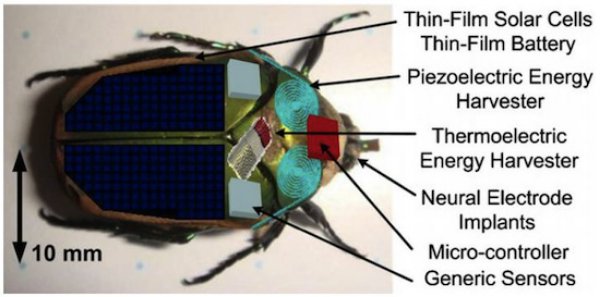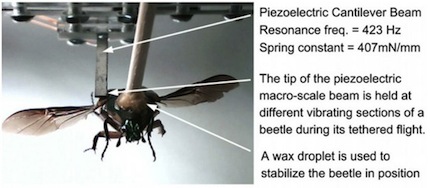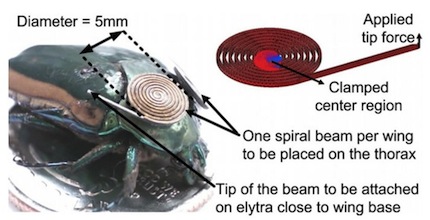 Researchers have been working on designing and fabricating micro-air-vehicles (MAVs), flying robots the size of small insects, but always come up against the difficulty of creating a tiny, lightweight aircraft capable of carrying a payload and being powered by a long-life onboard power source. Researchers at the University of Michigan have recently stopped trying to copy real-life insects and started using the insects themselves, going a step further in removing the need for an external power source.
Researchers have been working on designing and fabricating micro-air-vehicles (MAVs), flying robots the size of small insects, but always come up against the difficulty of creating a tiny, lightweight aircraft capable of carrying a payload and being powered by a long-life onboard power source. Researchers at the University of Michigan have recently stopped trying to copy real-life insects and started using the insects themselves, going a step further in removing the need for an external power source.
They have achieved this by harvesting the wing energy of an insect. The insect gets its energy from its daily food and then that energy is used by it to fly and the energy is wasted. The research team took advantage of the wasted energy by attaching piezoelectric generators to the wings of the insect.
This experiment was done on a Green June Beetle and yielded around 45 µW of energy per insect. The beetle had certain implants for controlling it brain and movement to a certain extent which was previously powered by batteries. Researchers believe that the energy generated could be increased through a direct connection to the insect’s muscles.
 The researchers placed the piezoelectric cantilever beams on the wings of the insect . These devices are designed to operate at 85-105 Hz at the flapping frequency of the Green June Beetle.
The researchers placed the piezoelectric cantilever beams on the wings of the insect . These devices are designed to operate at 85-105 Hz at the flapping frequency of the Green June Beetle.
 There could be a further an increase in the energy harvested by using tiny solar cells on the top of the wings. This research could enable the extended operation of Micro Air Vehicles (MAV) or Cyborg. This also makes the beetle lighter and makes it capable of carrying tiny devices like camera or tracking electronics.
There could be a further an increase in the energy harvested by using tiny solar cells on the top of the wings. This research could enable the extended operation of Micro Air Vehicles (MAV) or Cyborg. This also makes the beetle lighter and makes it capable of carrying tiny devices like camera or tracking electronics.
The detailed study can be accessed from a recent online issue of the Journal of Micromechanics and Microengineering : PhysOrg
Source: Crazy Engineers
